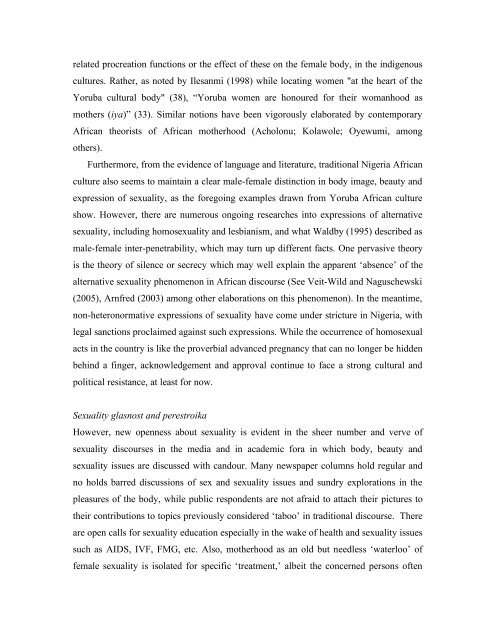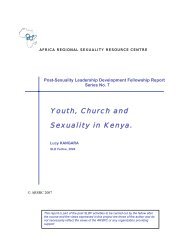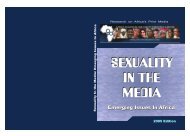body images beauty culture and language - Africa Regional ...
body images beauty culture and language - Africa Regional ...
body images beauty culture and language - Africa Regional ...
You also want an ePaper? Increase the reach of your titles
YUMPU automatically turns print PDFs into web optimized ePapers that Google loves.
elated procreation functions or the effect of these on the female <strong>body</strong>, in the indigenous<br />
<strong>culture</strong>s. Rather, as noted by Ilesanmi (1998) while locating women "at the heart of the<br />
Yoruba cultural <strong>body</strong>" (38), “Yoruba women are honoured for their womanhood as<br />
mothers (iya)” (33). Similar notions have been vigorously elaborated by contemporary<br />
<strong>Africa</strong>n theorists of <strong>Africa</strong>n motherhood (Acholonu; Kolawole; Oyewumi, among<br />
others).<br />
Furthermore, from the evidence of <strong>language</strong> <strong>and</strong> literature, traditional Nigeria <strong>Africa</strong>n<br />
<strong>culture</strong> also seems to maintain a clear male-female distinction in <strong>body</strong> image, <strong>beauty</strong> <strong>and</strong><br />
expression of sexuality, as the foregoing examples drawn from Yoruba <strong>Africa</strong>n <strong>culture</strong><br />
show. However, there are numerous ongoing researches into expressions of alternative<br />
sexuality, including homosexuality <strong>and</strong> lesbianism, <strong>and</strong> what Waldby (1995) described as<br />
male-female inter-penetrability, which may turn up different facts. One pervasive theory<br />
is the theory of silence or secrecy which may well explain the apparent ‘absence’ of the<br />
alternative sexuality phenomenon in <strong>Africa</strong>n discourse (See Veit-Wild <strong>and</strong> Naguschewski<br />
(2005), Arnfred (2003) among other elaborations on this phenomenon). In the meantime,<br />
non-heteronormative expressions of sexuality have come under stricture in Nigeria, with<br />
legal sanctions proclaimed against such expressions. While the occurrence of homosexual<br />
acts in the country is like the proverbial advanced pregnancy that can no longer be hidden<br />
behind a finger, acknowledgement <strong>and</strong> approval continue to face a strong cultural <strong>and</strong><br />
political resistance, at least for now.<br />
Sexuality glasnost <strong>and</strong> perestroika<br />
However, new openness about sexuality is evident in the sheer number <strong>and</strong> verve of<br />
sexuality discourses in the media <strong>and</strong> in academic fora in which <strong>body</strong>, <strong>beauty</strong> <strong>and</strong><br />
sexuality issues are discussed with c<strong>and</strong>our. Many newspaper columns hold regular <strong>and</strong><br />
no holds barred discussions of sex <strong>and</strong> sexuality issues <strong>and</strong> sundry explorations in the<br />
pleasures of the <strong>body</strong>, while public respondents are not afraid to attach their pictures to<br />
their contributions to topics previously considered ‘taboo’ in traditional discourse. There<br />
are open calls for sexuality education especially in the wake of health <strong>and</strong> sexuality issues<br />
such as AIDS, IVF, FMG, etc. Also, motherhood as an old but needless ‘waterloo’ of<br />
female sexuality is isolated for specific ‘treatment,’ albeit the concerned persons often






